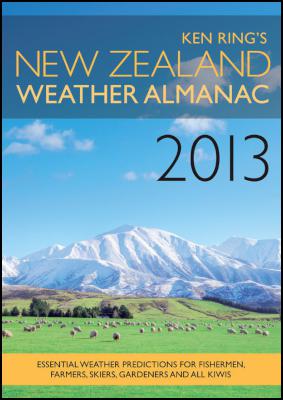2013 Is A Year of Weather Surprises
2013 IS A YEAR OF WEATHER
SURPRISES

Ken Ring’s New Zealand Weather
Almanac 2013
Author: Ken Ring
RRP: $50.00
Released: 14 September 2012
Imprint: Random House NZ
Ken Ring’s weather forecasts have been relied on by Kiwis for over 15 years, and his annual weather almanacs are always eagerly anticipated. September sees the publication of the 2013 Almanac in which Ken suggests that next year will be one of weather surprises.
So
what can you expect?
•
NZers can be prepared for a delightful December, possible
heat waves in January, the late arrival of autumn and a late
start to winter.
• The cyclone season should be light and late, with a number of threats that turn to fizzers, with the first real significant scare (but resulting in minimal impact) not until March.
• March heavy rains look likely to bring floods.
• January is often dry and sunny. February is sunny and mild. March may have wet periods. April is warm and wet and May is sunny and mild. June is stormy and July is cold and snowy. August may be cold but not very wet. September is wet for the South Island but dry for top half of the North Island. October is cloudy and wet. November is sunny but cool. The second and third weeks in December are dry for the North island and Canterbury.
• Most public holidays in 2013, including
Waitangi Day and Easter, may be wet. Want to know
more?
Ken
Ring’s New Zealand Weather Almanac 2013 can
allow you to accurately calculate the weather for any day in
the year ahead, anywhere in the country. Inside you’ll
find day-per-page forecasts, fishing and gardening guides
for each day of the year, daily weather maps and short
forecasts for every major centre, extreme weather warnings,
expected temperatures, sunshine and rainfall for over 50
locations, and much more.
How does Ken Ring’s forecasting method work?
For the longer outlook, one can liken our work in long-range weather projection to local tide-tables which cover a year ahead or longer. The science is based around the concept of the air and sea as an interactive system, giving rise to the daily tide of the air. By such daily vertical motion, well documented by weather balloon behaviour, a change in air-height can result in change of temperature and thereby daily variation in water vapour amount and density.
Our long-range weather reports are simply tide-tables of the atmosphere. This manifests in more or less sunshine and heat, or amounts of rain, wind and snow being able to form and affect a location.
By applying cycles to historical weather data that match tide cycles we believe we can produce useful indications of what weather may arrive and roughly when for any locality, and so warn about extreme weather that may disrupt events. The method is as scientific as the science of ocean tides and just as accurate. Why it is embraced in eastern countries but not in the west mirrors the struggle Chinese medicine has had to gain acceptance, which has had more to do with politics, religion and cultural difference than efficacy.
The range of all forecasting is a radius of 50-60 miles (80-100km). This is also the range of acceptable error. Weather forecasting is not an exact science. Up to two-days either side of a daily prediction should be allowed. Figures are always to be regarded as trends and focus points, rather than literal amounts. Small readings e.g. 1-2mm can mean dew, frost, mist, fog, drizzle, haze, or odd showers. Readings are of potential only, and forecasting for rain may just eventuate in the gathering of cloud.
That aside, usefulness is the criterion and the worth of the exercise. Upon examination it will be found that tide tables are also less than absolutely precise because many factors affect tide height like moon phase, declination angle, speed and proximity, wind direction, atmospheric pressure, and underwater eruptions and emissions. But tide charts and tables can provide a guide about tidal movements that is better than nothing. The advantages of accessing this information can also provide competitive advantage.
Ken Ring’s method of predicting weather by the cycles of the moon has attracted - and continues to attract - widespread media and public interest. His high hit rate for reliably predicting weather has attracted a wide following, evidenced by the many endorsements he receives from around the world.
WinchFest2012 organisers are counting their lucky stars
they sought a weather prediction for this weekend’s event.
Sun is forecast for both days of the action sports and music
festival which starts on Saturday in Oakura, and ‘Moon
Man’ Ken ring is the one they are thanking. - Taranaki
Daily News, 27 January 2012 Thanks Ken for your email, and
keep up your good work! We are farmers, and we have farmed
with your +/- 80% forecast for years. We always look forward
for your predictions.
- Pieter and Sabina van
Leeuwen
ENDS


 Courtney Duncan: Illness Prevents Duncan From Contesting First Round Of 2025 World Women’s Motocross Championship
Courtney Duncan: Illness Prevents Duncan From Contesting First Round Of 2025 World Women’s Motocross Championship GPNZ: Extended Skill Mix In Primary Care Teams Improves Patient Access And Outcomes
GPNZ: Extended Skill Mix In Primary Care Teams Improves Patient Access And Outcomes New Zealand Symphony Orchestra: Music Legend To Conduct Bach, Beethoven And Mozart With NZSO
New Zealand Symphony Orchestra: Music Legend To Conduct Bach, Beethoven And Mozart With NZSO Ministry of Health: Ministry Of Health To Look Further At Waikato Hospital Event
Ministry of Health: Ministry Of Health To Look Further At Waikato Hospital Event Emirates Team NZ: Statement From Emirates Team NZ On Auckland Hosting Of 38th America’s Cup
Emirates Team NZ: Statement From Emirates Team NZ On Auckland Hosting Of 38th America’s Cup PPTA Te Wehengarua: Draft English Curriculum Lacks Connection With Reality
PPTA Te Wehengarua: Draft English Curriculum Lacks Connection With Reality